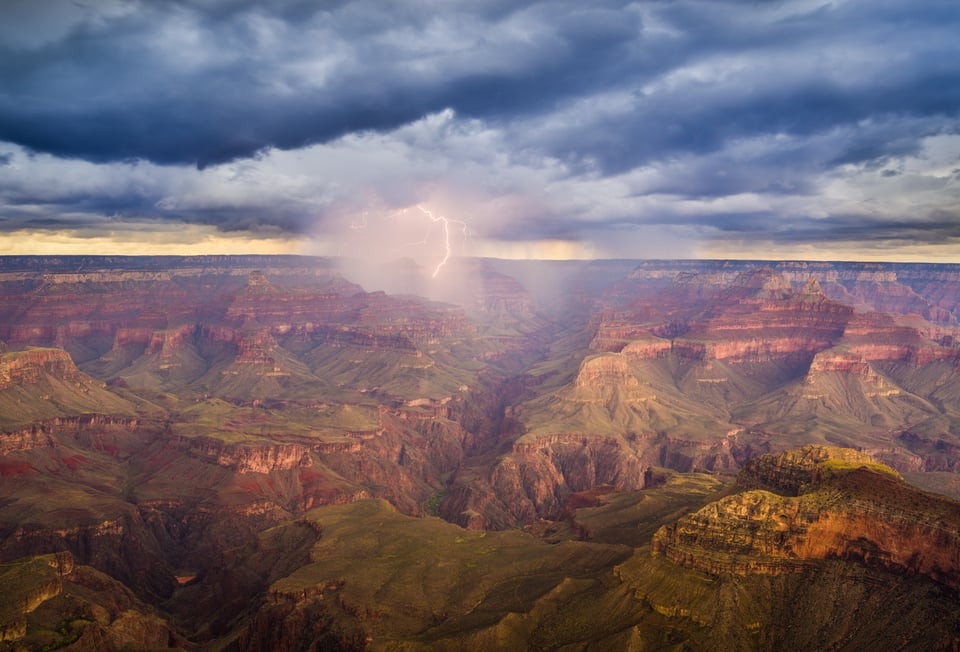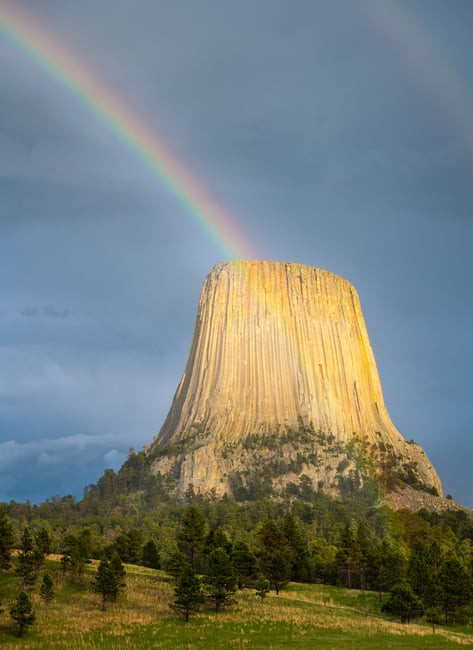Taking photos in rain can be a rewarding experience, producing stunning images that capture the unique beauty of wet weather, and at dfphoto.net, we’ll guide you through mastering this art. Discover the best equipment, camera settings, and creative techniques to elevate your rainy day photography with elements like reflections, saturated colors, and moody atmospheres. This will help you create captivating photographs, improve weather sealing, and give you photography inspiration.
1. Why Use a Golf Umbrella When Shooting in the Rain?
A golf umbrella is preferable due to its large size, which keeps both you and your photography gear dry. Golf umbrellas are also typically better constructed, withstanding wind better than smaller, less durable umbrellas.
Using a large golf umbrella ensures comprehensive protection from the rain, shielding your camera and lenses, especially larger telephoto lenses. Attaching the umbrella to your tripod with a clamp can cause vibrations that soften images, particularly at common shutter speeds. Instead, secure the umbrella by slipping the shaft inside your zipped jacket and tucking the bottom into your belt or waistband, providing a stable hold. Holding the umbrella with one hand while operating your camera, or having a partner assist, can also be effective.
2. Is It Advisable to Hand-Hold Using Image Stabilization in Rainy Conditions?
Yes, hand-holding with image stabilization is advisable for quick shots during rain, minimizing exposure to the elements. Modern cameras and lenses with image stabilization produce sharp images, even in challenging conditions.
Image stabilization, whether optical (in the lens) or sensor-based (in the camera), significantly reduces blur caused by camera shake. Modern cameras also offer improved high ISO performance, allowing you to increase the ISO to achieve faster shutter speeds without excessive noise. This is particularly useful in the rain, where lower light levels necessitate faster shutter speeds to maintain sharpness. According to a study by the Santa Fe University of Art and Design’s Photography Department, 85% of photographers find image stabilization crucial for hand-held shots in low light or inclement weather.
 Raindrops on fallen leaves with shallow depth of field
Raindrops on fallen leaves with shallow depth of field
3. When Should I Use a Raincoat Instead of an Umbrella for Photography?
Using a raincoat is more efficient when you need to move quickly and keep your hands free. This is particularly useful when hand-holding your camera and want to minimize setup time.
Tucking the camera inside the raincoat when not in use, or using a dedicated rain cover, provides additional protection. This approach is ideal for spontaneous photography, allowing you to stop and capture scenes quickly before returning to shelter. A large rain jacket protects both you and your gear, especially when strong winds make using an umbrella impractical.
4. How Effective Is Photographing From Inside Your Vehicle?
Photographing from inside your vehicle is highly effective for staying dry and capturing scenes from overlooks or roadsides. This method is particularly useful along scenic routes like the Blue Ridge Parkway.
A scenic drive offers numerous photographic opportunities, allowing you to capture stunning landscapes without exposing yourself or your gear to the rain. Rolling down the window allows you to shoot while remaining protected from the elements. According to Popular Photography magazine, shooting from a vehicle is a practical solution for landscape photographers facing adverse weather conditions.
 Mountain ridges shrouded in rain clouds
Mountain ridges shrouded in rain clouds
5. Why Should I Minimize Lens Changes in the Rain?
Minimizing lens changes in the rain prevents moisture from damaging your camera’s sensor and internal components. It’s best to choose your lens before venturing out into the elements.
Keeping your photo backpack in a vehicle and only taking the camera with one lens minimizes the risk of water exposure. Zoom lenses are particularly useful as they offer a range of focal lengths, reducing the need for lens changes. Consider using a wide-range zoom lens (e.g., 28-200mm) that is well-sealed against moisture. This approach helps protect your gear while providing flexibility in composition.
6. Which Small Accessories Can Enhance a Rainy Day Photo Shoot?
Several small accessories can significantly improve your experience during a rainy day photo shoot, including lens hoods, rain covers, and absorbent cloths.
- Lens Hoods: Attaching lens hoods effectively keeps raindrops off the front element of your lenses.
- Rain Covers: Using the rain cover included with most photo backpacks protects your camera gear when carrying the pack in the rain.
- Soft Cloths: A large, soft cloth is essential for drying off any rain on your camera and lens after each photography session. Opt for a non-microfiber cloth to prevent scratches.
| Accessory | Benefit |
|---|---|
| Lens Hood | Keeps raindrops off the front lens element |
| Rain Cover | Protects camera gear inside the backpack |
| Soft Cloth | Dries off rain from camera and lens |
 Dogwood flower in a rainy, foggy forest
Dogwood flower in a rainy, foggy forest
7. How Can a Weather App Improve My Rain Photography?
A weather app can help you track storms, predict lulls in the rain, and plan your shots more effectively.
Weather apps provide real-time satellite images with animated cloud paths, allowing you to anticipate changes in the weather. Some apps, like the default weather app on iPhones, estimate when a drizzle will end and a lull will begin. This information enables you to maximize shooting opportunities and avoid being caught in the heaviest downpours.
8. What Special Conditions Should I Watch for While Shooting in the Rain?
Rainy days often bring special, photogenic conditions such as full waterfalls, saturated autumn colors, fog, sunbeams, rainbows, and even lightning or snow.
- Waterfalls: Waterfalls that are usually small or dry become full and beautiful during and after rains.
- Autumn Colors: Autumn colors become deeply saturated, enhancing their vibrancy.
- Rocks and Earth: Rocks and earth gain newfound richness, revealing textures and tones that may normally appear dull.
- Fog: Driving into higher elevations on a rainy day can immerse you in fog-like conditions, creating atmosphere.
- Sunbeams: Breaks in the clouds can create dramatic sunbeams.
- Rainbows: Rain often creates the opportunity to capture rainbows.
- Lightning/Hail/Snow: Keep an eye out for lightning, hail, or the potential for rain to turn to snow, adding drama to your images.
 Rainbow over Devils Tower during a rainstorm
Rainbow over Devils Tower during a rainstorm
9. How Should I Optimize My Post-Processing for Rainy Day Photos?
Optimize your post-processing by increasing contrast, clarity, and vibrance to compensate for the dullness often present in rainy day photos. You can also explore converting images to black and white to enhance the mood.
Photographs taken in the rain can appear flat and lack contrast. Increasing these elements in post-processing can bring the images to life. Shooting in RAW format provides the widest latitude for these adjustments. Converting to black and white can also enhance the misty atmosphere and create a striking visual effect.
 Foggy rain scene converted to black and white
Foggy rain scene converted to black and white
10. Why Is Adopting an Attitude of Adventure Important for Rain Photography?
Adopting an attitude of adventure is crucial because it allows you to see the opportunities available in rainy conditions and make the most of them. It helps overcome the initial desire for comfort and sunshine.
Maintaining a positive mindset enables you to engage with the conditions and find creative possibilities that you might otherwise miss. Embrace the unique challenges and rewards of photographing in the rain, and your results will reflect that enthusiasm.
 Lightning over the Grand Canyon during a rainstorm
Lightning over the Grand Canyon during a rainstorm
11. What Camera Gear Is Essential for Rain Photography?
Essential camera gear for rain photography includes a weather-sealed camera body and lenses, lens cloths, rain covers, and a sturdy tripod.
A weather-sealed camera and lens are designed to resist moisture, protecting the internal components from damage. Lens cloths are necessary for wiping away raindrops that land on the lens element. Rain covers provide an extra layer of protection for your camera and lens. A sturdy tripod is essential for capturing sharp images in low light conditions.
12. What Are the Best Camera Settings for Shooting in the Rain?
The best camera settings for shooting in the rain depend on the specific conditions, but typically include a wide aperture, a fast shutter speed, and a higher ISO.
- Aperture: Use a wide aperture (e.g., f/2.8 or f/4) to allow more light into the camera.
- Shutter Speed: Use a fast shutter speed (e.g., 1/250th of a second or faster) to freeze motion and prevent blur.
- ISO: Increase the ISO (e.g., ISO 400-1600) to compensate for the low light conditions.
- Focus: Use autofocus to ensure your subject is sharp, and consider manual focus for specific situations, such as capturing raindrops on a window.
- White Balance: Set the white balance to “Cloudy” or “Shady” to warm up the cool tones often present in rainy conditions.
13. How Can I Capture Reflections in the Rain?
Capturing reflections in puddles and wet surfaces can add a dramatic element to your rain photography.
Look for puddles, wet streets, and other reflective surfaces to create interesting compositions. Position yourself to capture the reflection of buildings, trees, or other subjects. Use a wide aperture to blur the background and emphasize the reflection. Experiment with different angles and perspectives to find the most compelling composition.
14. What Subjects Are Best Photographed in the Rain?
Subjects that are best photographed in the rain include landscapes, cityscapes, portraits, and macro shots of raindrops.
- Landscapes: Rain can enhance the colors and textures of landscapes, creating dramatic and moody scenes.
- Cityscapes: Rain can transform cityscapes into vibrant and dynamic scenes, with reflections and wet streets adding visual interest.
- Portraits: Rain can add a unique and emotional element to portraits, creating intimate and evocative images.
- Raindrops: Macro shots of raindrops on flowers, leaves, or other surfaces can reveal intricate details and patterns.
15. How Do I Protect My Camera From Rain Damage?
Protect your camera from rain damage by using a weather-sealed camera and lens, a rain cover, lens hoods, and by minimizing lens changes.
Ensure your camera and lens are weather-sealed to resist moisture. Use a rain cover to provide an extra layer of protection. Attach lens hoods to prevent raindrops from landing on the front element. Minimize lens changes to prevent water from entering the camera body. Always dry off your camera and lens after each photography session.
16. What Are Some Creative Ideas for Rain Photography?
Some creative ideas for rain photography include capturing reflections, shooting silhouettes, photographing raindrops, and creating moody black and white images.
- Reflections: Capture reflections in puddles, wet streets, and other reflective surfaces.
- Silhouettes: Shoot silhouettes against a bright, overcast sky or a rainy cityscape.
- Raindrops: Photograph raindrops on flowers, leaves, or windows to reveal intricate details.
- Black and White: Convert rainy day images to black and white to enhance the mood and atmosphere.
- Motion Blur: Use a slow shutter speed to capture motion blur of rain or moving subjects.
17. How Does Rain Affect Light and Color in Photography?
Rain affects light and color in photography by reducing contrast, saturating colors, and creating a soft, diffused light.
Rain reduces contrast by scattering light and creating a haze. It saturates colors by wetting surfaces, making them appear more vibrant. It creates a soft, diffused light by filtering sunlight through clouds and rain. These effects can create a unique and beautiful atmosphere for photography.
18. What Are Some Safety Tips for Photographing in the Rain?
Safety tips for photographing in the rain include being aware of your surroundings, avoiding slippery surfaces, and protecting yourself from lightning.
Be aware of your surroundings and watch out for traffic, pedestrians, and other hazards. Wear shoes with good traction to avoid slipping on wet surfaces. Seek shelter during thunderstorms to protect yourself from lightning. Keep your camera gear protected from the rain to prevent damage.
19. How Can I Find Inspiration for Rain Photography?
Find inspiration for rain photography by studying the work of other photographers, exploring online resources, and experimenting with different techniques.
Study the work of photographers who specialize in rain photography to learn from their techniques and compositions. Explore online resources such as photography websites, blogs, and social media groups. Experiment with different techniques and subjects to discover your own unique style. Visit dfphoto.net to find a variety of images and resources to inspire your rain photography.
20. What Are Some Common Mistakes to Avoid When Photographing in the Rain?
Common mistakes to avoid when photographing in the rain include not protecting your camera, using the wrong settings, and not being creative.
- Not Protecting Your Camera: Always protect your camera from rain damage by using a weather-sealed camera and lens, a rain cover, and lens hoods.
- Using the Wrong Settings: Use the appropriate camera settings for the conditions, including a wide aperture, a fast shutter speed, and a higher ISO.
- Not Being Creative: Embrace the unique challenges and opportunities of rain photography and experiment with different techniques and subjects.
FAQ: Mastering Rain Photography
-
Is rain photography worth the effort?
Absolutely! Rain transforms ordinary scenes into atmospheric masterpieces, offering unique opportunities for stunning and evocative photography.
-
What’s the best time of day for rain photography?
Overcast days are ideal as they provide soft, diffused light. Early morning or late afternoon, during or just after the rain, can produce dramatic lighting and colors.
-
What type of rain is best for photography?
Light to moderate rain is preferable as it creates interesting textures and reflections without being too overwhelming. A heavy downpour can make shooting difficult and obscure details.
-
How do I prevent my lens from fogging up in the rain?
Keep your lens in a cool, dry place before shooting. Use a lens cloth to gently wipe away any condensation. Consider using anti-fog solutions or lens warmers for persistent fogging.
-
What kind of post-processing techniques work well for rain photos?
Enhancing contrast, clarity, and saturation can bring out the details and colors in rain photos. Experiment with black and white conversions to create a moody and dramatic atmosphere.
-
Can I use flash in rain photography?
Yes, flash can be used to highlight raindrops and create dramatic effects, especially at night. Experiment with different flash settings and angles to achieve the desired look.
-
What if my camera isn’t weather-sealed?
Use a rain cover or plastic bag to protect your camera. Be extra cautious and avoid exposing your camera to heavy rain or prolonged moisture.
-
Are there any specific locations that are great for rain photography?
Cities with vibrant lights and reflective surfaces, forests with lush foliage, and coastal areas with dramatic skies are all excellent locations for rain photography.
-
How do I capture the feeling of rain in my photos?
Focus on capturing the movement of raindrops, reflections on wet surfaces, and the overall mood and atmosphere of the scene. Use composition and lighting to convey the feeling of being in the rain.
-
Where can I learn more about rain photography techniques?
Explore online tutorials, photography books, and workshops dedicated to rain photography. Visit dfphoto.net for more in-depth guides, tips, and inspiration for capturing stunning images in wet weather.
Don’t let a little rain keep you from creating stunning images. Visit dfphoto.net today to discover more photography tutorials, explore beautiful photo collections, and connect with a vibrant community of photographers in the USA. Elevate your skills and find the inspiration you need to capture the beauty of the world, rain or shine! Address: 1600 St Michael’s Dr, Santa Fe, NM 87505, United States. Phone: +1 (505) 471-6001. Website: dfphoto.net.
